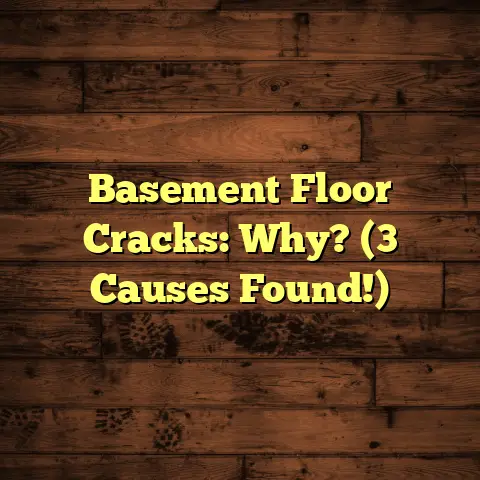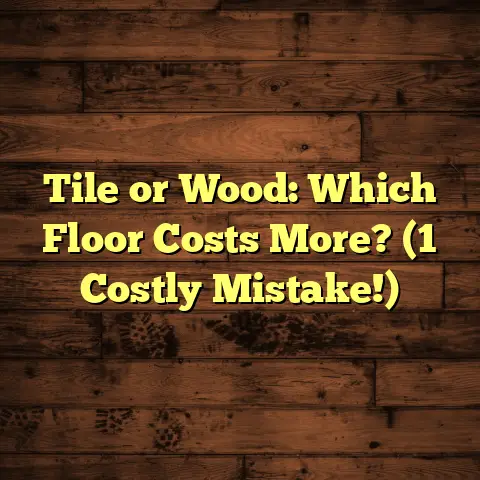Do Floating Floors Create Noise? (9 Causes)
What if you just moved into your dream home, excited to unpack and make it your own?
You step onto your brand-new floating floor, and instead of the serene silence you expected, you hear an unsettling creak with every step.
Suddenly, your dream home feels more like
a noisy nightmare.
What causes this unexpected
sound?
Could it be the floor itself, or perhaps
an issue beneath the surface?
Let’s dive in!
1. As a contractor who’s spent years knee-deep in sawdust and adhesive, I’ve seen it all when it comes to floors.
Let’s talk about floating floors. What exactly are they?
Unlike traditional floors that are nailed or glued
down, floating floors aren’t attached to the
subfloor.
They “float” above it.
Think of it like a puzzle.
The pieces (planks
or tiles) interlock, creating a single, unified
surface.
Common materials?
We’re talking laminate,
engineered wood, and luxury vinyl plank (LVP).
Each has its own vibe and price point.
Installation is a breeze, usually involving a
tongue-and-groove system or a click-lock mechanism.
This makes them a favorite for DIYers.
One of the biggest advantages is versatility.
You can install them over various subfloors,
like concrete, plywood, or even existing tile.
2. The Acoustic Properties of
Floating Floors
Now, let’s get a little geeky and talk acoustics.
Every material has its own unique sound profile.
Think about tapping on a piece of wood versus
tapping on a piece of metal.
Totally different,
right?
Sound travels as waves.
When these waves hit
a surface, some of the energy is absorbed,
some is reflected, and some is transmitted.
Floating floors, especially laminate and LVP,
tend to be denser materials.
This means they can
transmit sound more easily than, say, carpet.
Sound transmission is key here.
It’s how sound
moves through the floor and into the rooms below.
Without proper underlayment, floating floors can act like a drum, amplifying every footstep.
3. Cause #1: Improper Installation
Okay, let’s get to the nitty-gritty.
Improper
installation is a HUGE culprit when it comes
to noisy floating floors.
I’ve seen some real horror shows over the years!
One of the biggest mistakes is not leaving enough expansion gap around the perimeter of the room.
Floating floors expand and contract with changes
in temperature and humidity.
If they don’t have
room to breathe, they can buckle and creak.
An unlevel subfloor is another major issue.
Even
small dips and bumps can cause the planks to rub
against each other, creating annoying squeaks.
Imagine walking on a seesaw that’s slightly
off-balance.
That’s what it’s like for your
floating floor!
For example, I once worked on a job where the
homeowner swore the floor was haunted.
Turns
out, the subfloor had a significant dip in the
middle of the room.
Every step caused the planks
to flex and groan.
4. Cause #2: Subfloor Condition
Speaking of subfloors, their condition is
absolutely critical.
Think of the subfloor as
the foundation of your floating floor.
If the foundation is weak, the whole structure
is at risk.
Cracks, uneven surfaces, and moisture
problems are all red flags.
Cracks can create voids beneath the floating floor, leading to hollow sounds and excessive movement.
Uneven surfaces cause the planks to flex and rub, generating squeaks and creaks.
Moisture is a silent killer.
It can warp the
subfloor and promote mold growth, which can
lead to even more noise issues.
Before installing any floating floor, it’s
essential to assess the subfloor.
I always
recommend using a level and a moisture meter
to check for any potential problems.
5. Cause #3: Environmental Factors
Mother Nature can be a real pain when it comes
to floating floors.
Humidity and temperature
changes can wreak havoc on these materials.
Wood and wood-based products like laminate are hygroscopic, meaning they absorb and release moisture from the air.
In humid conditions, the planks will expand.
In dry conditions, they’ll contract.
This
constant movement can lead to creaking and
popping noises.
Seasonal changes are especially noticeable.
In the winter, when the air is dry, you might
hear more noise than in the summer, when the
air is more humid.
According to the EPA, ideal indoor humidity
levels should be between 30% and 50%.
Maintaining this range can help minimize
the effects of expansion and contraction.
6. Cause #4: Foot Traffic and
Weight Distribution
Let’s face it: floors are meant to be walked on.
But foot traffic and the weight of furniture can
contribute to noise generation.
The physics are pretty simple.
When you step
on a floating floor, the weight is distributed
across the planks.
If the weight is unevenly distributed, some
planks will flex more than others.
This can
cause them to rub against each other or against
the subfloor, creating noise.
Different types of footwear can also exacerbate
the issue.
Hard-soled shoes, like dress shoes
or boots, tend to generate more noise than
soft-soled shoes, like slippers or sneakers.
Think about it: walking on a floating floor in heels is like tap-dancing on a drum!
7. Cause #5: Lack of Soundproofing
Here’s a hard truth: most floating floors aren’t
designed to be soundproof.
They’re designed to
be affordable and easy to install.
That’s where underlayments and sound barriers
come in.
These materials are installed between
the floating floor and the subfloor to help
absorb and dampen sound.
Underlayments come in various materials,
including foam, cork, and rubber.
Each has
its own soundproofing properties.
Sound barriers are typically made of dense
materials like mass-loaded vinyl (MLV).
They
are designed to block sound from traveling
through the floor.
According to the Acoustical Society of America,
using a high-quality underlayment can reduce
impact noise by up to 20 decibels.
That’s a
significant difference!
8. Cause #6: Age and Wear
Like anything else, floating floors age and wear
over time.
The constant foot traffic, furniture
movement, and environmental factors can take
their toll.
The materials can break down, leading to increased
noise.
Laminate floors, for example, can develop
micro-fractures in the wear layer, which can cause
them to squeak.
Engineered wood floors can delaminate, meaning
the layers of wood start to separate.
This can
create voids beneath the surface, leading to
hollow sounds.
Regular maintenance is key to extending the
life of your floating floor and minimizing noise.
This includes sweeping, vacuuming, and occasional
damp mopping.
I always recommend using a floor cleaner that’s
specifically designed for floating floors.
Harsh
chemicals can damage the finish and accelerate
the breakdown of the materials.
9. Cause #7: Type of Flooring Material
Not all floating floors are created equal when
it comes to noise.
The type of material you
choose can have a big impact on how noisy your
floor is.
Laminate floors tend to be the noisiest.
They
have a hard surface that doesn’t absorb sound
very well.
Engineered wood floors are generally quieter
than laminate.
The wood layers help to dampen
sound.
Luxury vinyl plank (LVP) is often the quietest
option.
It’s softer and more flexible than
laminate or engineered wood, which helps to
absorb sound.
According to a study by the National Wood
Flooring Association, engineered wood floors
have an average sound transmission class (STC)
rating of 50, while laminate floors have an
average STC rating of 45.
The higher the STC
rating, the better the soundproofing.
10. Cause #8: Room Acoustics
Believe it or not, the acoustics of the room itself can influence the perception of noise from floating floors.
A room with hard surfaces, like tile or concrete walls, will reflect sound more easily than a room with soft surfaces, like carpet or curtains.
Ceiling height is another factor.
High ceilings
can create more reverberation, which can amplify
noise.
Furniture arrangement can also play a role.
A
room with lots of furniture will absorb more
sound than a room with minimal furniture.
Think of it like this: an empty room is like
an echo chamber.
Every sound bounces around,
creating a cacophony of noise.
Adding rugs, curtains, and upholstered furniture can help to dampen the sound and create a more peaceful environment.
11. Cause #9: Interaction with Other
Flooring Types
Finally, let’s talk about how floating floors interact with other types of flooring in adjacent areas.
Transitions between different flooring systems, like tile or carpet, can create sound issues.
For example, if you have a floating floor in your living room and tile in your kitchen, the sound can transfer between the two rooms.
The difference in height between the two floors can also create a tripping hazard and amplify noise.
To minimize these issues, I recommend using a transition strip to create a smooth and seamless transition between the two floors.
You can also use a sound barrier to block sound from traveling between the rooms.
Conclusion
So, do floating floors create noise?
As we’ve
seen, the answer is a resounding “it depends!”
Improper installation, subfloor condition, environmental factors, foot traffic, lack of soundproofing, age and wear, type of flooring material, room acoustics, and interaction with other flooring types can all contribute to the problem.
Being informed about these potential causes can
help you make better decisions regarding
installation, maintenance, and material selection.
That way, your dream home remains serene and
enjoyable for years to come.





